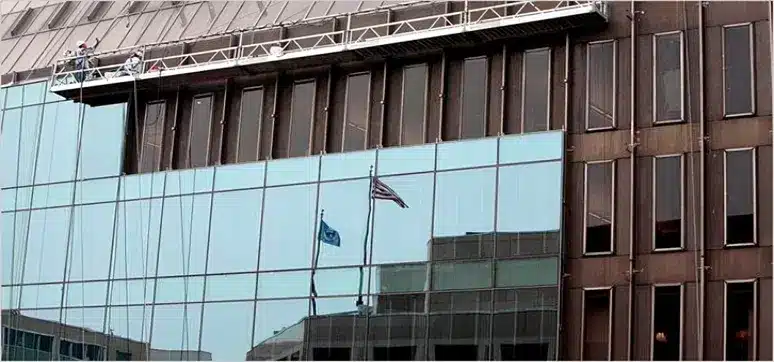In the dynamic landscape of contemporary architecture, glass façades stand as iconic symbols of modernity, sophistication, and connectivity with the surrounding environment. However, amidst the growing discourse on sustainability in the built environment, the excessive use of glass in building façades has come under scrutiny for its environmental impacts. In this article, we aim to delve into the nuanced considerations surrounding the strategic reduction of glass in building façades, exploring its multifaceted environmental benefits and implications within the broader context of sustainable architectural design.
Environmental Imperatives and Strategies
Glass, renowned for its luminous qualities and architectural allure, has pervaded modern building design, particularly in façades. Yet, its ubiquitous presence poses significant environmental challenges, spanning energy consumption, carbon emissions, and resource depletion. The environmental impact of glass usage encompasses multiple dimensions, from energy-intensive production processes to operational inefficiencies. Efforts to mitigate these impacts necessitate a multipronged approach, emphasising reduction strategies, and alternative design paradigms.
Energy Efficiency
A fundamental consideration in optimising glass usage lies in its significant impact on building energy efficiency. While glass offers unparalleled visual transparency and aesthetic allure, its inherent thermal properties present challenges for building insulation Excessive glass coverage can result in heightened energy consumption for heating and cooling, leading to increased greenhouse gas emissions. Research indicates that a judicious reduction in the window-to-wall ratio can yield substantial energy savings. For example, a reduction from 70% to 50% in the window-to-wall ratio in a hypothetical building spanning 10,000 square meters could translate to an annual energy saving of approximately 750,000 kWh per year.
Resource Conservation
The production of glass is intrinsically resource-intensive, requiring significant amounts of energy, raw materials, and water. By curbing the deployment of glass in building façades, architects can make substantial contributions to resource conservation efforts. This strategic shift towards responsible material utilisation helps mitigate adverse environmental impacts associated with glass extraction, processing, and fabrication.
Moreover, embracing alternative façade materials with lower environmental footprints further reinforces sustainable design practices and promotes a more holistic approach to resource conservation. Studies have shown that the embodied carbon of some alternative façade materials can be significantly lower than that of glass, contributing to overall carbon emission reductions.
Emissions Reduction
Glass manufacturing processes contribute significantly to carbon and greenhouse gas emissions. By adopting a judicious approach to glass usage, architects can effectively mitigate both embodied and operational carbon emissions. Recalibrating the window-to-wall ratio could potentially yield a notable reduction in CO2 emissions annually.
For instance, a reduction from 70% to 50% in the window-to-wall ratio could lead to a reduction of approximately 275 metric tons of CO2 emissions per year, thus advancing global initiatives aimed at combating climate change and environmental degradation.
Waste Reduction
End-of-life considerations for glass panels necessitate responsible waste management practices. By diminishing reliance on glass in façades, architects concurrently minimise waste generation and promote sustainable disposal methodologies. Designing with recyclability in mind facilitates material recovery and reuse, thereby curbing the environmental footprint associated with construction and demolition activities.
Additionally, embracing circular economy principles, such as designing for disassembly and promoting material reuse, fosters a holistic approach to waste reduction and resource conservation throughout the building lifecycle.
Strategies for Reducing Glass Usage
Efforts to mitigate the environmental impact of glass in building façades necessitate a multipronged approach, emphasising reduction strategies, and alternative design paradigms. Architects and designers can adopt several key strategies to minimise glass usage:
- Optimise Fenestration Design: Rationalise fenestration design to prioritise functionality over aesthetics, minimising glass area while maximising energy efficiency and occupant comfort. According to the Efficient Windows Collaborative, energy-efficient windows can reduce heating and cooling energy consumption by 10% to 30% compared to single-pane windows.
- Embrace Passive Design Principles: Integrate passive design principles to optimise natural light penetration and thermal comfort without overreliance on glass. Strategically orient buildings to leverage solar exposure and utilise shading devices to mitigate solar heat gain, reducing the need for extensive glazing.
- Explore Alternative Materials: Explore alternative façade materials with lower environmental footprints, such as engineered wood, recycled metals, or innovative composite materials. According to the U.S. Green Building Council, the embodied carbon of some alternative façade materials can be significantly lower than that of glass, contributing to overall carbon emission reductions.
- Prioritise Functional Transparency: Prioritise functional transparency over decorative embellishment, focusing on glass usage where essential for daylighting, views, and spatial connectivity. Employ glazing selectively, concentrating on key areas while minimising overall façade coverage.
- Conduct Life Cycle Assessments: Conduct comprehensive life cycle assessments (LCAs) to evaluate the environmental impacts of façade materials and design choices. Consider factors such as embodied carbon, energy consumption, and end-of-life considerations to inform sustainable decision-making.
Conclusion
The strategic reduction of glass in building façades emerges as a pivotal component of sustainable architectural practice. By prioritising energy efficiency, resource conservation, emissions reduction, and waste management, architects pave the way for a more resilient and environmentally conscious built environment. Through thoughtful design interventions, innovative material choices, and interdisciplinary collaboration, architects can usher in a new era of sustainable architecture, characterised by balance, innovation, & environmental stewardship.
Fact File
- U.S. Department of Energy (DOE): energy.gov
- Efficient Windows Collaborative: efficientwindows.org
- U.S. Green Building Council (USGBC): usgbc.org
- Building and Environment Journal: www.journals.elsevier.com/buildingandenvironment
- Athena Sustainable Materials Institute: athenasmi.ca
- Leadership in Energy and Environmental Design (LEED): usgbc.org/leed
- Building Research Establishment Environmental Assessment Method (BREEAM): breeam.com














